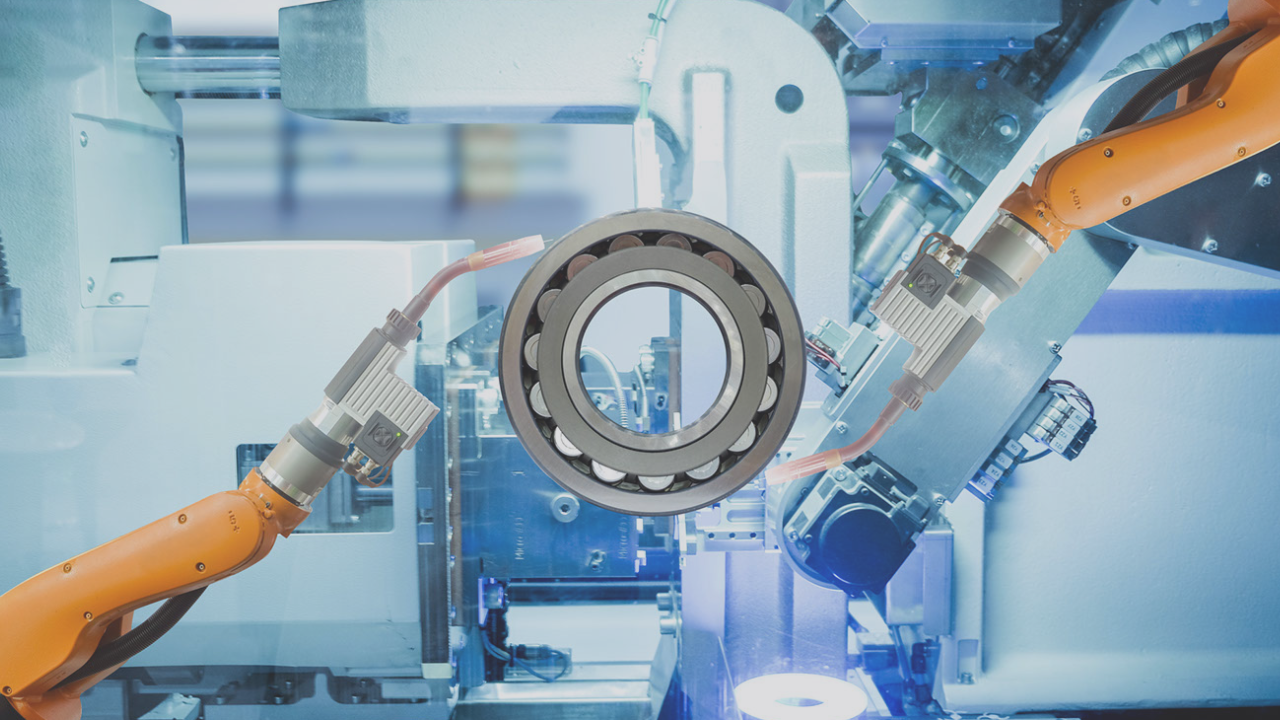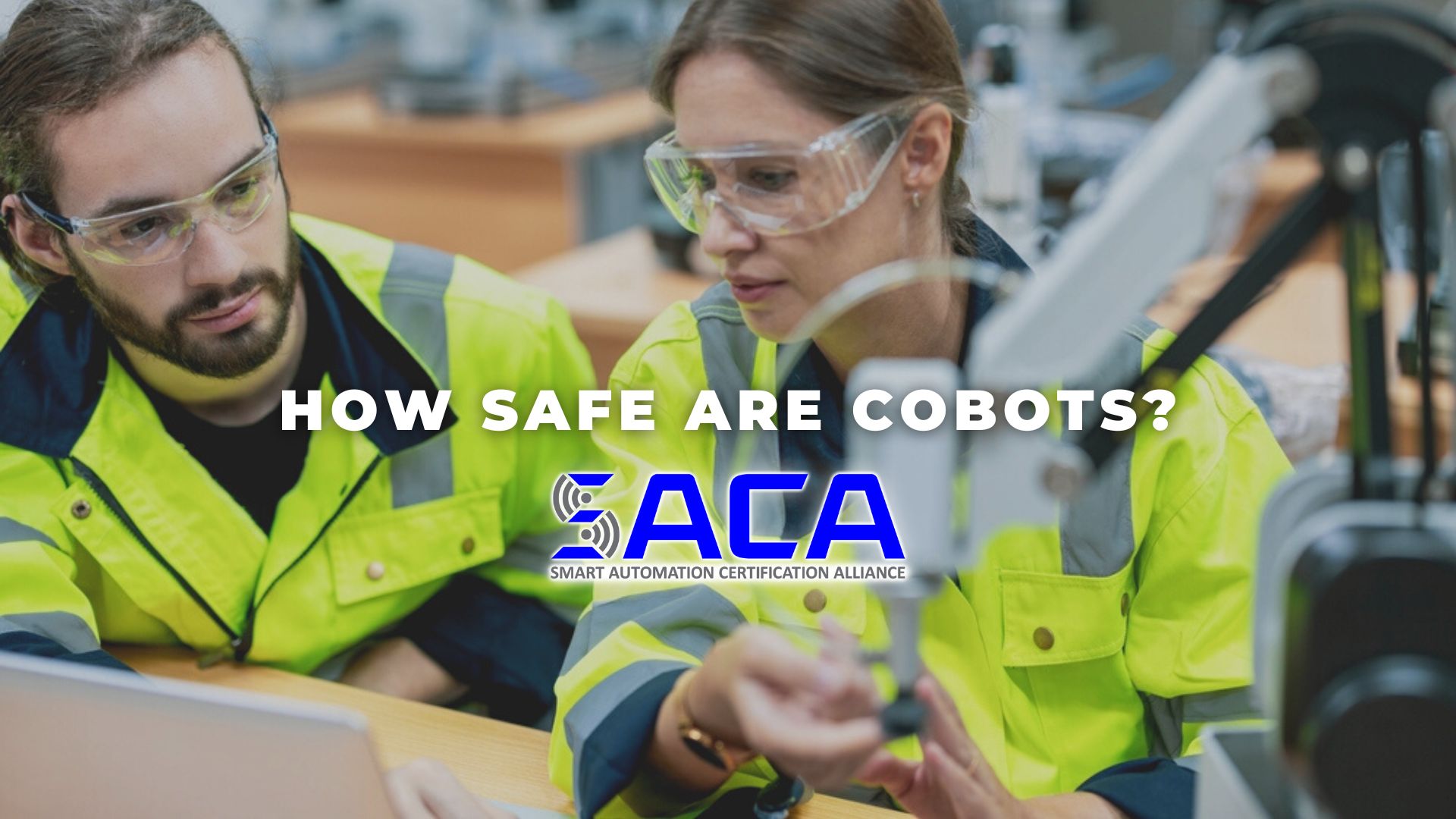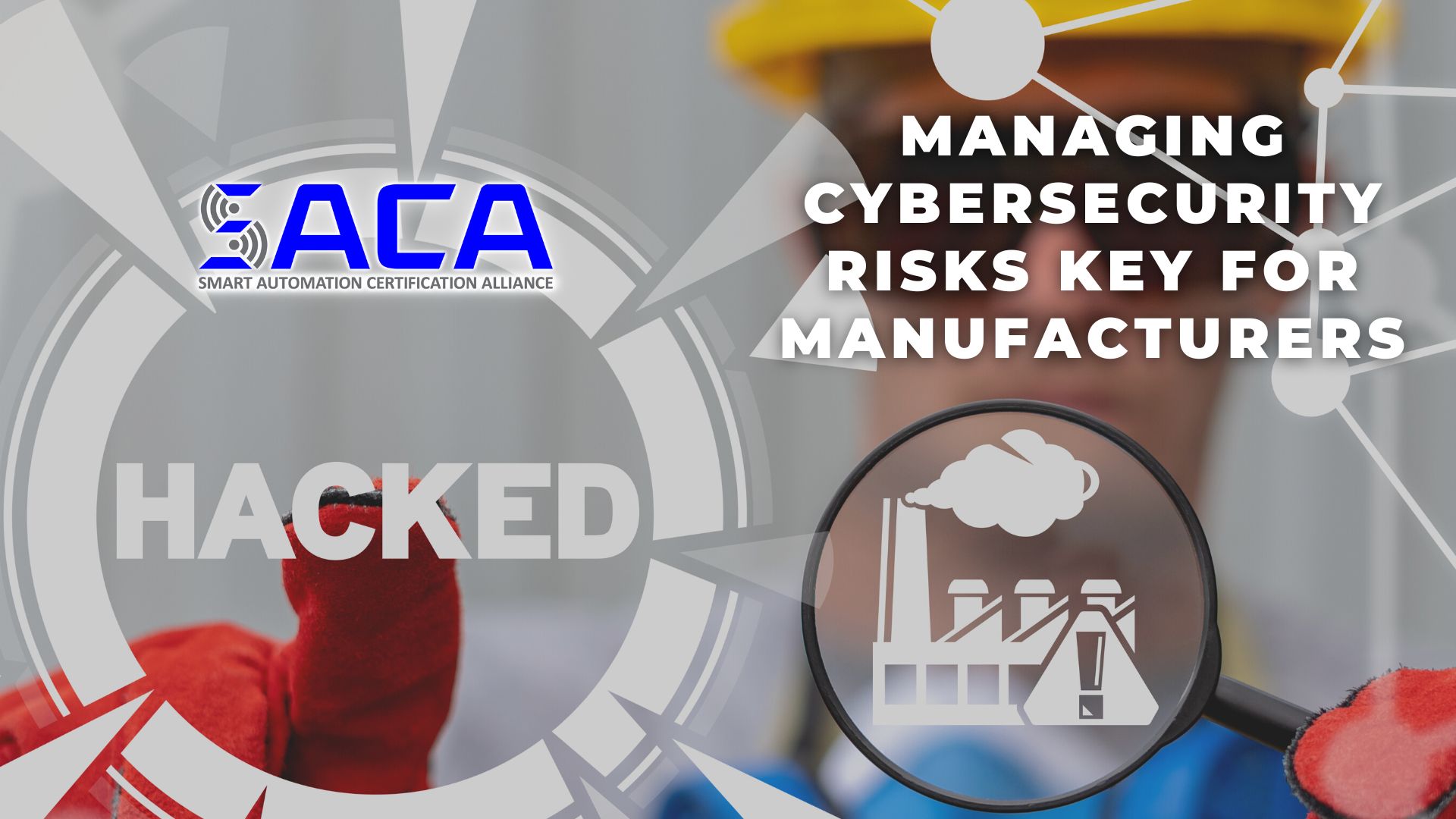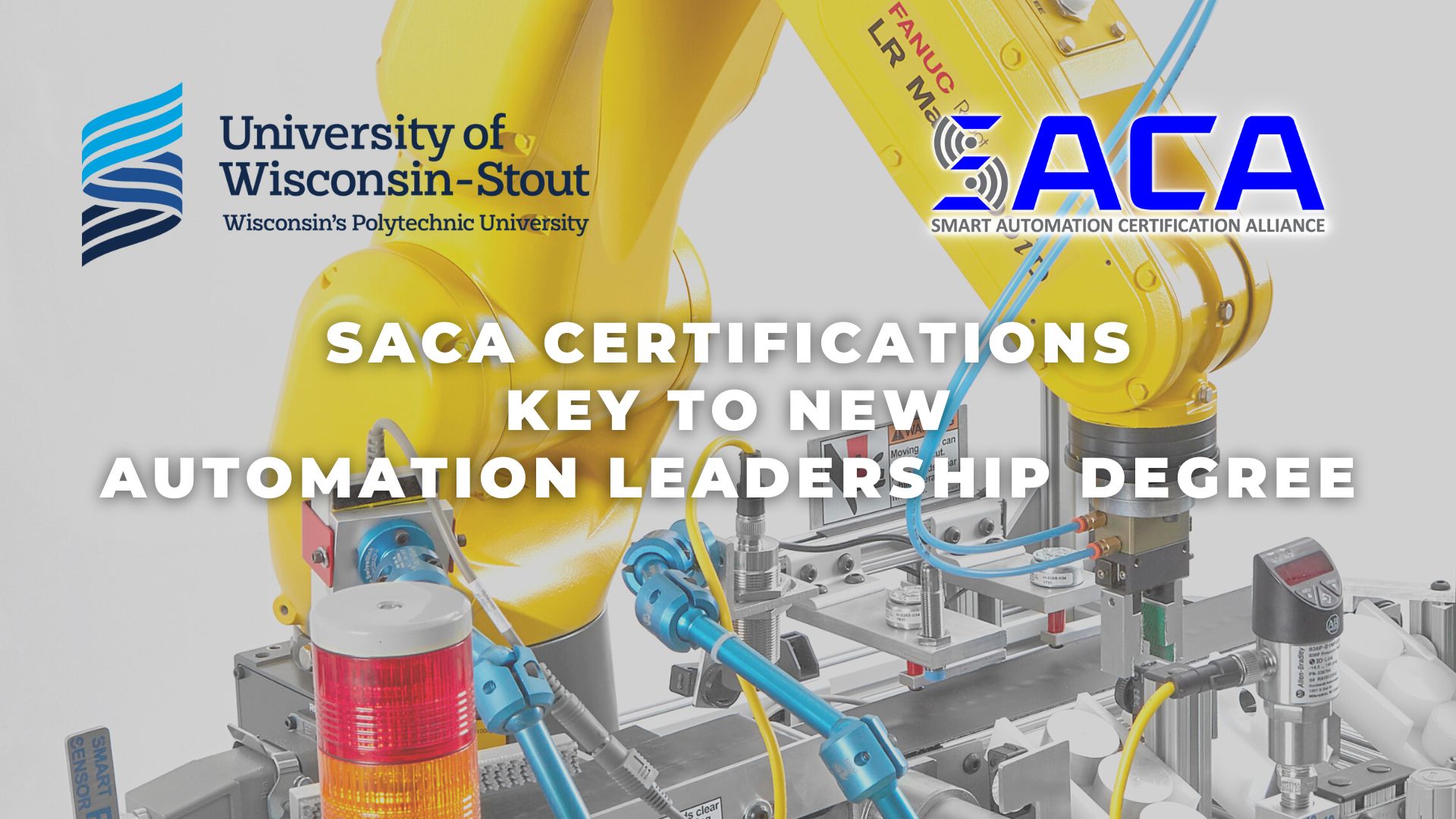Risk Assessment Still Essential to Ensure Cobot Safety
As advanced automation technologies have become commonplace in industrial workplaces over the last decade, many workers have feared that their jobs would soon be replaced by these technologies, such as robots. However, while some dangerous, overly-repetitive job tasks have been taken over by industrial robots, these technologies have actually created a variety of new jobs centered on their installation, operation, maintenance, troubleshooting, and repair.
Moreover, many workers now find themselves working right alongside robots that make their jobs easier and safer. These robots, known as collaborative robots or cobots, tend to be smaller, slower-moving versions of their industrial robot counterparts.
Cobots are designed to operate at slower speeds and with more safeguards than traditional robots, so that they can safely operate in close proximity to human workers. Despite these design considerations and the safety record of cobots, experts argue that ongoing risk assessment remains essential to ensure cobots and human workers continue to work safely together.
According to a recent Automation World article by David Greenfield, “beyond the built-in safety aspects of cobots—such as smooth, rounded edges to minimize pinch points, slow operating speeds and lighter load capacities—key safety regulations have been introduced to help ensure a safe working environment.”
For example, “ISO/TS15066 clearly calls out that a risk assessment is necessary to identify the hazards and risks associated with a collaborative robot system application. It notes that the integrator ‘shall conduct a risk assessment as described by ISO 10218 and ANSI/RIA15.06’.”
Risk assessment of automated industrial applications seems like a no-brainer, right? Unfortunately, “cobot risk assessments are commonly overlooked in industry.” Why? Probably because “[t]heir use in industry over the past 10+ years has proven their ability to be used safely.”
According to Greenfield, “[t]ypical application hazards, such as impact questions, trapping and projectiles are often overlooked once the term collaborative robot is used because it’s taken that this is a safe piece of equipment. But this is why a risk assessment is required. So you have to look at the loads, the materials and the robot torque.”
It’s also important to assess risk “related to the cobot’s location. Based on where the cobot is located, you have to consider if you are creating a crushing or a trapping hazard with the cobot. You also have to consider if the cobot position is high enough that it could come into contact with an operator’s head.”
“The bottom line for cobot safety is to: 1) Not assume it will always be safe to use alongside humans just because it’s a cobot; and 2) Identify the hazards and risks associated with your planned use of the cobot using the available safety standards.”
Does your organization use cobots in the workplace? If so, do you have risk assessment procedures in place to ensure worker safety? These types of questions are why it’s critical for industries to hire highly skilled workers that can manage risks, in addition to operating, maintaining, troubleshooting, and repairing the advanced automation systems that are being implemented.
Unfortunately, due to the ongoing “skills gap” issue facing industries across the country, finding highly skilled workers remains a significant challenge. How can employers find the workers they need? And how can they be sure that workers have the hands-on skills they need to succeed in the modern workplace? Today, more and more employers are looking for workers with industry-standard certifications that prove they have the skills needed.
For example, if workers possess a certification from the Smart Automation Certification Alliance (SACA), employers can feel confident they’ve already proven they have the knowledge and hands-on skills needed for working with advanced smart automation technologies. SACA has been hard at work collaborating with industry leaders to develop a wide variety of industry-standard certifications that will help employers find workers who possess the advanced connected-systems skills they need to take their businesses to the next level. Be sure to check out SACA and all it has to offer!
- Published in News
SACA/MICHauto/MWTEC/LEO Electric Vehicle Certification Summit
Join us for the SACA/MICHauto/MWTEC/LEO exclusive Electric Vehicle Certification Summit
The Smart Automation Certification Alliance (SACA) is partnering with MICHauto, the Michigan Workforce Training and Education Collaborative (MWTEC), and the Michigan Department of Labor and Economic Opportunity (LEO) for the Electric Vehicle Certification Summit. The Summit will include in-depth discussion about what industry-approved certifications are needed to train and upskill the Electric Vehicle and Electric Battery workforce. This event will also include the development of standards and validation of SACA’s Electric Vehicle Battery Basics certification.
We’re calling on automotive industry experts to attend the Summit and offer your expertise. This is an opportunity for your organization to have input on the skills and competencies needed for today’s Electric Vehicle and Electric Battery workforce.
Your input will be used to create nationally-recognized, occupation-driven certifications and EV training programs for careers like Operator/Assembler and Technician/Skilled Tradesman. Additionally, SACA will seek your feedback on future needs of industry and technology trends that will help shape their strategy moving forward.
Interested? Here are the details:
SACA/MICHauto/MWTEC/LEO Electric Vehicle Certification Summit
December 7, 2023
MICHauto
One Kennedy Square
777 Woodward Ave, Suite 800
Detroit, MI 48226
For more information including an agenda, download the brochure.
About SACA
SACA sits at the forefront of the effort to certify students and workers who demonstrate the required knowledge and hands-on smart automation skills employers so desperately need. SACA’s certifications were developed in conjunction with industry partners who could speak from experience about their needs when it comes to workers able to work alongside a variety of advanced automation technologies.
SACA offers a wide variety of certifications in popular industrial skill areas, including certifications at the Associate, Specialist, and Professional level. For those wishing to focus on building a strong foundation of skills employers need, SACA also offers many micro-credentials that allow students and workers to add certifications as they master new areas.
For workers, SACA certifications can help market their smart automation skills to potential employers. For those employers, SACA certifications represent confirmation that a worker has the skills to hit the ground running in the workplace. To learn more about Industry 4.0 certifications and how SACA can help both future workers and industrial employers begin the task of bridging the Industry 4.0 skills gap, contact SACA for more information.
- Published in News
How Safe is Your Plant Floor from Cyberattacks?
Do you work in a smart factory? From the smartphone in your pocket to the smart thermostat on the wall at home, devices that are part of connected systems have taken over our modern lives, and that includes the factory floor.
Even if your industrial facility isn’t filled with a bunch of robots or a fleet of automated guided vehicles, chances are good that at least some advanced automation technologies have made their way into operations in some way, shape, or form. And if they haven’t yet, these technologies are sure to appear soon.
Manufacturers everywhere have embraced new automation technologies because they improve productivity, efficiency, and ultimately profitability. However, as manufacturers add more and more smart devices to their networks, the risk of cyberattacks on those devices increases accordingly.
The bad actors behind the cyberattacks that have made the news in the last few years know that manufacturers often implement new technologies before adding the highly skilled workers they need to keep those advanced systems safe. How safe is your plant floor from cyberattacks?
According to a recent Automation World article by Matt Smith, “[i]ndustrial control systems (ICS) and operations technology (OT) are vulnerable to cyberthreats and vulnerabilities that target crucial industrial processes. The effects go far beyond data breaches and have the power to upend entire industries, jeopardize security and even put lives in danger.”
Smith provides several examples of the types of problems that can arise if a facility’s cybersecurity isn’t managed properly:
- “Any successful cyberattack on OT/ICS technologies could cause system downtime and significantly reduce productivity…As a result, financial impacts can be significant, with losses in market reputation and investor confidence in addition to revenue losses.”
- “[A] cyberattack on the control systems of a power plant could cause power outages that would impact not only businesses but also homes, hospitals and other vital services that depend on electricity.”
- “Accidents and fatalities can result from a successful attack on transportation infrastructure, such as rail networks or traffic control systems.”
- “Pipeline or chemical plant control system breaches can cause spills, leaks and other environmental catastrophes with long-term ecological and financial repercussions.”
How can manufacturers take steps to minimize the risk of cyberattacks? According to Smith, “strong cybersecurity measures are increasingly necessary to reduce these risks as industries place a greater reliance on connected systems. Businesses need to understand that cybersecurity is a key component of their overall risk management strategy, not just an IT issue.”
That’s why it’s critical for manufacturers to hire highly skilled workers that can manage cybersecurity risks, in addition to operating, maintaining, troubleshooting, and repairing the advanced automation systems that are being implemented. Unfortunately, due to the ongoing “skills gap” issue in the manufacturing sector, finding highly skilled workers remains a significant challenge.
How can manufacturers find the workers they need? And how can they be sure that workers have the hands-on skills they need to succeed in the modern workplace? Today, more and more manufacturers are looking for workers with industry-standard certifications that prove they have the skills employers need. For example, if workers possess a certification from the Smart Automation Certification Alliance (SACA), employers can feel confident they’ve already proven they have the knowledge and hands-on skills needed for working with advanced smart automation technologies. SACA has been hard at work collaborating with industry leaders to develop a wide variety of industry-standard certifications that will help employers find workers who possess the advanced connected-systems skills they need to take their businesses to the next level. Be sure to check out SACA and all it has to offer!
- Published in News
SACA & Endress+Hauser Seek Experts for Technical Work Group
The Smart Automation Certification Alliance (SACA) is pleased to announce that it is partnering with Endress+Hauser to host an exclusive Process Control Technical Work Group meeting on November 28, 2023, in Greenwood, Indiana.
SACA and Endress+Hauser need experts in the process control and instrumentation industry to help validate certification standards for process control in four key areas:
- Process Control Systems 1-Flow and Level
- Process Control Troubleshooting 1
- Process Control Systems 2-Temperature
- Smart Process Instrumentation 1
This meeting represents your opportunity to provide input on the skills and competencies needed for today’s smart manufacturing workforce. Your input will be used to create nationally-recognized, occupation-driven certifications. Additionally, SACA will seek your feedback on future needs of industry and technology trends that will help shape its strategy moving forward.
Why should you participate? Not only will you gain recognition as a national leader in process control automation and first access to state-of-the-art industry standards, but you’ll also ensure that your company’s skill needs are addressed by a nationally-recognized certification.
Interested? Here are the details:
SACA and Endress+Hauser Process Control Technical Work Group
November 28, 2023
Endress+Hauser Inc.
2355 Endress Place, Greenwood, IN 46143
Click here to download a flyer with the agenda.
Plan to attend? RSVP here.
About SACA
SACA sits at the forefront of the effort to certify students and workers who demonstrate the required knowledge and hands-on smart automation skills employers so desperately need. SACA’s certifications were developed in conjunction with industry partners who could speak from experience about their needs when it comes to workers able to work alongside a variety of advanced automation technologies.
SACA offers a wide variety of certifications in popular industrial skill areas, including certifications at the Associate, Specialist, and Professional level. For those wishing to focus on building a strong foundation of skills employers need, SACA also offers many micro-credentials that allow students and workers to add certifications as they master new areas.
For workers, SACA certifications can help market their smart automation skills to potential employers. For those employers, SACA certifications represent confirmation that a worker has the skills to hit the ground running in the workplace. To learn more about Industry 4.0 certifications and how SACA can help both future workers and industrial employers begin the task of bridging the Industry 4.0 skills gap, contact SACA for more information.
- Published in News
Believe the Hype: The Current State of Smart Manufacturing
It’s no secret that technology has changed our personal lives in ways few could have foreseen decades ago. But to what extent has technology changed the way we work?
People unfamiliar with the manufacturing sector might assume that factories where people work with their hands to make things might not be on the frontier of technological progress. However, they might be surprised to learn that the nation’s manufacturing facilities are driving forces when it comes to advanced technology.
There’s even a name for the technological revolution taking place throughout manufacturing: Industry 4.0. This term refers to the fact that we’re in the midst of a fourth Industrial Revolution, in which advanced automation technologies powered by Internet-connected systems are transforming the way modern manufacturing facilities operate.
This phenomenon goes by a variety of different monikers, including Smart Factory, the Industrial Internet of Things (IIoT), and Smart Manufacturing. It’s gotten a lot of attention over the past several years, leading some to question whether all the hype is justified.
After all, there are plenty of people who work in facilities that remain largely unchanged from the way they’ve always been. Is technology really transforming manufacturing the way the media portrays?
In a nutshell, the answer is yes. If you haven’t jumped aboard the Industry 4.0 train yet, it’s time to make your way to the station. Believe the hype. The current state of manufacturing is smarter and more automated than ever before, and it’s only growing and accelerating. As Blake Moret, Chairman and Chief Executive Officer of Rockwell Automation, recently noted, “We’ve experienced 20 years of evolution in 2 years.”
In this article, we’ll take a closer look at a few of the conclusions reached by experts at Rockwell Automation and Plex, in association with Sapio Research, in their Eighth Annual State of Smart Manufacturing Report (the “report”).
Challenges Spurring Technology Investments
Why are so many manufacturers choosing to invest in advanced smart automation technologies? That’s one of the questions the authors of the report looked at when developing questions for their survey of 1,353 global manufacturers across 13 of the top manufacturing countries.
What they learned is that many manufacturers see technology as a means to address one or more of the many challenges they face in today’s manufacturing environment. For example, “[s]killed labor – and labor of any kind – continues to be elusive across the globe. As manufacturers continue to seek opportunities for profitable growth, they’re finding that uncertainty in workforce availability is impacting quality, along with their ability to meet their customers’ needs and transform at pace. They are addressing this impact by using technology to extract data from their operations and assemble actionable insights.”
As manufacturers compete for skilled labor, they’re also competing with other manufacturers globally for customers and market share. The authors of the report “are also seeing how technology is helping the industry accelerate their agility and competitive differentiation.”
In fact, “manufacturers view technology as an advantage for improving quality, agility, innovation, and to attract the next generation of talent. Manufacturers expect to mitigate risk through technology tied to processes and people to build resiliency and drive future success.”
The Current State of Smart Manufacturing
Knowing that manufacturers are increasingly turning to advanced automation technologies to address the many challenges they’re facing, the authors of the report sought to gauge both the current levels of technology adoption and manufacturers’ plans for the future.
Before jumping into those findings, though, it’s important to understand what we’re talking about when we refer to “smart manufacturing.” According to the Manufacturing Enterprise Solutions Association (“MESA International”), “Smart Manufacturing is the intelligent, real-time orchestration and optimization of business, physical, and digital processes within factories and across the entire value chain. Resources and processes are automated, integrated, monitored, and continuously evaluated based on all available information as close to real time as possible.”
Manufacturers embracing smart manufacturing technologies are doing so “to mitigate risks, open up new opportunities, and remain competitive.” In terms of risk management, manufacturers face both internal and external risks.
According to the report, “[t]he top two ways respondents are addressing internal risk are to adopt new technology aimed at minimizing disruption from workforce or supply issues (53%) and to shift their operations to the cloud for purposes including increased cybersecurity protection and business continuity (50%). When it comes to external risks like inflation, supply chain, and workforce shortages, the top-ranking mitigation tactic is adopting new technology (44%).”
So exactly how many respondents are we talking about? The report concludes that “[e]ighty-four percent of respondents have adopted smart manufacturing or are actively evaluating solutions with the intention to invest in the coming year.” That’s an astounding adoption rate, which shows clearly the role these technologies play today and will continue to play in the future.
The report did note a difference in adoption rate based upon available revenue: “Companies with higher revenues are more likely to have adopted smart manufacturing technology, with a 58% adoption rate among respondents in the top third for revenue, compared to 40% among the lower revenue bracket.”
This finding is unsurprising, but the report indicates it “may indicate an opportunity for small and mid-size organizations to leverage an incremental, lower initial cost and resource approach to smart manufacturing with modular solutions that provide strong value and quick time to payback and ROI.”
With manufacturing becoming a more global phenomenon every year, it’s worth noting that investment in advanced automation technologies isn’t limited to the United States. Indeed, the top three countries with the greatest adoption rates of smart manufacturing technologies are “China (70%), the US (60%) and India (57%).”

Smart Manufacturing Solutions Abound
So what exactly are these advanced automation technologies we’re talking about when we discuss smart manufacturing? The report summarizes a set of ten smart manufacturing solutions manufacturers are adopting:
- Smart Devices
“Smart devices are self and system-aware assets that acquire and process operating data – and monitor and report on asset conditions such as self-diagnostics and energy usage.”
- Manufacturing Execution Systems (MES)
“Manufacturing Execution Systems (MES) track and document the transformation of raw materials into finished goods, providing real-time production management to drive enterprise-wide compliance, quality, and efficiency.”
- Quality Management Systems (QMS)
“Quality Management Systems (QMS) standardize and automate quality documentation, processes, and measurements.”
- Computerized Maintenance Management Systems (CMMS)
“Computerized Maintenance Management Systems (CMMS) help organizations track and manage maintenance and repair activities for their facilities, equipment, and other assets in one place.”
- Asset Performance Management (APM)
“Asset Performance Management (APM) combines process, operational, and machine-level data through dashboards to monitor machine and plant health, ensuring optimal uptime, throughput, and maintenance needs.”
- Production Monitoring
“Production Monitoring provides seamless connectivity to machines on the plant floor, delivering transparent, real-time operational KPIs like OEE and dashboards to drive continuous improvements.”
- Distributed Control Systems (DCS)
“Distributed Control Systems (DCS) use decentralized elements to control dispersed systems, such as automated industrial processes or large-scale infrastructure systems.”
- Supply Chain Planning (SCP)
“Supply Chain Planning (SCP) combines data from multiple departments across the business or from outside market resources to sync demand and supply forecasting to improve inventory accuracy and production management.”
- Enterprise Resource Planning (ERP)
“Enterprise Resource Planning (ERP) automates front- and back-office processes, including financial management, revenue management, human capital, order management, billing, and inventory.”
- Analytics
“Analytics use data to solve manufacturing bottlenecks, optimize output and quality, and provide new insights.”
Contact SACA to Learn More about Smart Automation Certifications
As manufacturers incorporate these new advanced automation technologies, they’re finding they need workers with more advanced technical and technological skills than ever before. Unfortunately, there aren’t enough workers with these skills to fill the many roles available today, creating what is known throughout industry as the “skills gap.”
How can manufacturers find the highly-skilled workers they need so desperately? One promising solution is the development of industry-standard certifications that focus on connected-systems skills. The Smart Automation Certification Alliance (SACA) sits at the forefront of the effort to certify students and workers who demonstrate the required knowledge and hands-on smart automation skills employers so desperately need.
To learn more about Industry 4.0 certifications and how SACA can help both educational institutions and industry employers begin the task of bridging the Industry 4.0 skills gap, contact SACA for more information.
About Duane Bolin
Duane Bolin is a former curriculum developer and education specialist. He is currently a Marketing Content Developer for Amatrol, Inc. Learn more about Amatrol and its technical training solutions, including eLearning, here and connect with Duane on Amatrol’s Twitter, Facebook, LinkedIn, and YouTube pages.
- Published in News, Technology
SACA Certifications Key to New Automation Leadership Degree
The Smart Automation Certification Alliance (SACA) is pleased to announce that its certifications will play a key role in students pursuing a first-of-its-kind Automation Leadership degree at the University of Wisconsin-Stout.
On June 9, 2023, the UW System Board of Regents approved a new B.S. Automation Leadership degree at UW-Stout for enrollment this fall. As the university noted in its press release:
“The online program is designed for technical and community college students who have an associate degree and incorporates training in SACA…Students also can begin their career path in high school while taking college credits or, if working in industry, return to school as adult learners to finish their degree.”
SACA Executive Director Jim Wall is excited for students and workers who now have a new path to turn their SACA credentials into a bachelor’s degree. “It’s unprecedented that a university system would recognize a credentialing agency at this level,” noted Wall.
According to UW-Stout, “[o]ffering courses aligned with [SACA] standards, [the] Automation Leadership degree offers the relevant leadership and management training to enhance your industry-recognized credentials…[and] can be completed entirely online.”
SACA board member Matt Kirchner notes that “[t]he integration of industry-backed stackable credentials from the Smart Automation Certification Alliance, the alliances with technical colleges and the hands-on nature of the degree are unmatched.”
Kirchner, who also has 20 years of experience as an advanced manufacturing CEO and is currently president of ATS/LAB Midwest, a leading distributor of technical education learning materials, was instrumental in bringing industry experts into the process of developing both SACA credentials and the new Automation Leadership degree.
“We consult with advanced manufacturing employers in Wisconsin and throughout the Midwest – from smaller contract manufacturers to the Fortune 500,” Kirchner said. “Almost all of them tell us one of their greatest needs is for team members who understand automation, Industry 4.0, advanced control systems and process optimization and who can integrate highly advanced industrial technology and help lead a company’s digital transformation. People with these skills are in unbelievably high demand. This degree hits the mark with precision and does so in a genuinely innovative fashion.”
A wide variety of Wisconsin manufacturers assisted during the program’s development, including “Harley-Davidson, Kohler, Mercury Marine, Oshkosh Corp., Ashley Furniture, Generac, Greenheck Group and Plexus, as well as many medium and small manufacturers.”
About SACA
SACA sits at the forefront of the effort to certify students and workers who demonstrate the required knowledge and hands-on smart automation skills employers so desperately need. SACA’s certifications were developed in conjunction with industry partners who could speak from experience about their needs when it comes to workers able to work alongside a variety of advanced automation technologies.
SACA offers a wide variety of certifications in popular industrial skill areas, including certifications at the Associate, Specialist, and Professional level. For those wishing to focus on building a strong foundation of skills employers need, SACA also offers many micro-credentials that allow students and workers to add certifications as they master new areas.
For workers, SACA certifications can help market their smart automation skills to potential employers. For those employers, SACA certifications represent confirmation that a worker has the skills to hit the ground running in the workplace. To learn more about Industry 4.0 certifications and how SACA can help both future workers and industrial employers begin the task of bridging the Industry 4.0 skills gap, contact SACA for more information.
- Published in News
Certifications Facilitate Skills-Based Hiring
It’s no secret that industries around the world continue to struggle to fill open positions. Despite the ongoing recovery from the COVID-19 pandemic, industries such as manufacturing still need more highly-skilled workers than they can find.
What’s going on? Experts point to the ongoing “skills gap” issue that has plagued industries for years now. With the implementation of a wide variety of new advanced automation technologies, industry needs workers with more advanced technical skills than ever before. But where are they?
The supply of such workers continues to lag far behind demand, creating the shortages we’re seeing today. To combat these issues, many industries are making bold moves to find a solution. One trend gaining momentum is a new focus on skills-based hiring, which has led many employers to ditch advanced degree requirements in favor of searching for workers with the particular skills they need.
A switch to a skills-based hiring model isn’t necessarily intuitive for many industries that have always relied upon traditional four-year-degree requirements as a proxy for qualified applicants. Those making the switch, however, have found an easy way to help find workers with the skills they need: industry-standard certifications.
In this article, we’ll take a closer look at the move toward skills-based hiring. We’ll also dive into how industry-standard certifications make it easier for employers to feel confident that the workers they’re hiring have the skills they need to hit the ground running. Finally, we’ll explain how the Smart Automation Certification Alliance (SACA) has assembled a comprehensive set of industry-standard certifications and micro-credentials that can help any employer hire workers with the advanced technical skills they’ll need to thrive in the modern industrial workplace.
The Move to Skills-Based Hiring
For years, secondary schools have pushed students toward traditional four-year degrees. Why? That’s what employers have traditionally required to get hired. If you looked at job listings before the pandemic hit, you’d see listing after listing that included a requirement of some type of four-year degree.
Today, however, the hiring landscape is slowly changing. The number of open positions and the lack of highly-skilled workers to fill them have forced industries across the country to reevaluate their hiring practices.
According to a ComputerWorld article, many employers are finally realizing their degree requirements have been hindering their hiring efforts. The article notes:
“Among middle-skilled occupations, the openings that require college degrees are, for the most part, similar to those openings for which no degree is required, according to a recent study by Harvard Business School’s (HBS) Project on Managing the Future of Work and the Burning Glass Institute. ‘Jobs do not require four-year college degrees. Employers do,’ the study said. That realization is prompting companies to consider a shift in hiring practices that recognizes the nontraditional paths many have taken to develop technology skills — paths that don’t require a degree.”
The article also notes that the shift to skills-based hiring has begun to take off in the information technology sector: “with a 2% unemployment rate, the tech industry is rethinking what job applicants need to get hired. Skills-based hiring is on the rise, and 59% of employers are considering eliminating college degree requirements — changes that could reshape the IT workforce.”
What about the world beyond IT? According to a Harvard Business Review article, “employers are indeed resetting degree requirements in a wide variety of roles. The change is most noticeable for middle-skill positions — defined as those requiring some post-secondary education or training but less than a four-year degree.”
The Harvard Business Review article concludes: “[i]n evaluating job applicants, employers are suspending the use of degree completion as a proxy and instead now favor hiring on the basis of demonstrated skills and competencies. This shift to skills-based hiring will open opportunities to a large population of potential employees who in recent years have often been excluded from consideration because of degree inflation.”
The Role of Certifications in Skills-Based Hiring
If you’re a human resources professional, the obvious question you might be asking is: “how can I ensure candidates possess the skills needed if they don’t have a four-year degree?” This is a valid question, because most employers aren’t necessarily equipped to assess a candidate’s skill levels on their own.

If only there was a way for candidates to prove to prospective employers that they have the skills needed to be successful. We’re joking, of course, because candidates have been using industry-standard certifications to do exactly that for years now.
A wide variety of industry-standard certifications exist that certify that prospective workers possess the knowledge and, in many cases, proven hands-on skills in a particular area. Certifications come in many shapes and sizes, from micro-credentials that certify expertise in a narrow subject-matter area to more robust certifications that encompass a wide range of skills, such as all the necessary skills involved in industrial maintenance.
As skills-based hiring becomes more popular, it will be necessary for employers to become more familiar with the variety of certifications and credentials available to evidence the skills they seek. It will also be critical for educators and industries to work together to promote and encourage alternative credentialing.
A Deloitte report echoes this need:
“Alternative credentialing can encourage reskilling amid rapidly evolving technology. The shrinking shelf-life of digital skills requires continuous reskilling. Employers desire tracking and verification of those skills. As a result, the job market increasingly calls on training providers and academic institutions to offer “credentialized” records of learning and mastery. Rather than relying heavily on two- and four-year degrees, skill-specific microcredentials, digital badges, or certificates specify the exact technologies an applicant has mastered. This simplifies career shifts and employee selection, making labor markets more efficient.”
Fortunately, many economic and workforce development organizations around the country are already focusing more on certifications. According to the National Conference of State Legislatures, “[t]o better their workforces and provide additional economic opportunities to those who need it most, many states have put a focus on expanding postsecondary options for adult learners. These opportunities range from promoting career and technical education to expanding nondegree credentialing options.”
How SACA Certifications Facilitate Skills-Based Hiring
For companies looking for highly-skilled individuals to fill open positions, a good place to start is searching for prospective workers with certifications or micro-credentials from the Smart Automation Certification Alliance. SACA sits at the forefront of the effort to certify students and workers who demonstrate the required knowledge and hands-on smart automation skills employers so desperately need.
SACA’s certifications were developed in conjunction with industry partners who could speak from experience about their needs when it comes to workers able to work alongside a variety of advanced automation technologies. For example, SACA offers certifications in many key areas for a variety of industries, including basic to advanced operations; robot systems; and IIoT, networking, and data analytics.
SACA also offers specialist certifications, as well as micro-credentials, related to a variety of in-demand skills for systems such as automation, electrical, mechanical, fluid power, controls, and instrumentation. SACA’s certifications come in two forms: silver certifications are earned upon passing a knowledge exam and gold certifications are earned upon passing a hands-on skills test.
For workers, SACA certifications can help market their smart automation skills to potential employers. For those employers, SACA certifications represent confirmation that a worker has the skills to hit the ground running in the workplace.
To learn more about Industry 4.0 certifications and how SACA can help both future workers and industrial employers begin the task of bridging the Industry 4.0 skills gap, contact SACA for more information.
About Duane Bolin
Duane Bolin is a former curriculum developer and education specialist. He is currently a Marketing Content Developer for Amatrol, Inc. Learn more about Amatrol and its technical training solutions, including eLearning, here and connect with Duane on Amatrol’s Twitter, Facebook, LinkedIn, and YouTube pages.
- Published in News, Technology
“SACA Has Provided Me With Critical Skills”: A Conversation with Alex Topalovic
Alex Topalovic, a Project Manager at northern Indiana-based enFocus and recent Conexus Rising 30 award recipient, completed SACA C-101 and C-102 certifications in the spring of 2022 at the Ivy Tech -Elkhart/South Bend campus. We sat down with him to discuss why he chose to pursue SACA certifications and how he believes they’ve strengthened his understanding of advanced manufacturing and logistics (AML).
Topalovic is a native of Belgrade-Serbia, studied Global Management (‘19) at Earlham College in Richmond, Indiana, and then received a master’s degree from the Massachusetts Institute of Technology (MIT). Topalovic also completed internships at the Richmond Baking Company and Fiat Chrysler Automobiles, competed in supply chain competitions at ASCM Deloitte and Conexus Rolls-Royce, and co-founded Digital Leader, an IT startup / platform that helps high school teachers develop digital leadership and technology skills among their students.
Topalovic is also a recent winner of the Conexus Rising 30 award given to people under 30 years of age that are “bringing exceptional leadership and innovative thinking to bear on [advanced manufacturing and logistics] toughest challenges.” Conexus Indiana is a non-profit initiative that facilitates industry, academic, and public sector partnerships to position “the Hoosier State as the best place for advanced manufacturing and logistics industries to innovate, invest, employ and succeed.” Of the award, Topalovic said, “Conexus has allowed me to make several connections in the state and work to further bettering Indiana’s manufacturing industries.”
Currently working as a Project Manager at enFocus, Topalovic has been praised for playing a key role in actionable process improvements to “sharpen supply chain, manufacturing, R&D, and market access,” including the deployment of Transformation XP, which “helps companies improve on-time delivery, reduce stock outages, increase revenue, and improve customer satisfaction.”
“I work for enFocus because there are many opportunities in AML in the state of Indiana,” says Topalovic, “so I help with talent development and recruitment to the state. Working with organizations like the University of Notre Dame and the Eli Lilly Endowment, Inc., we create innovative research projects to attract and retain talent in South Bend area.” Specifically, in regards to Notre Dame, Topalovic works with iNDustry Labs, the university’s platform for collaborating with local industry.
SACA Certifications
Manufacturers looking to improve efficiency and increase productivity are increasingly looking to advanced Industry 4.0 technologies to automate their operations and processes. Technologies like artificial intelligence are transforming modern manufacturing facilities, but their adoption is not without hurdles.
In the spring of 2022, Topalovic completed Gold Certifications in C-101 (March 23,2022) and C-102 (May 17, 2022) within the Ivy Tech’s Smart Manufacturing and Digital Integration program. Topalovic says that his past experience with Rolls Royce and Deloitte Fiat prompted him to attain SACA certifications so that he could better understand the concepts and skills outlined in the C-101 and C-102 Credentials.
“SACA has provided me with critical skills through hands-on training, curriculum, and multimedia. I like the Silver and Gold certifications and the clear pathways through the program to achieve industry specific skills,” says Topalovic. Further, he said, “I like how the clear understanding of certification hierarchy levels, hands-on training skills, and curriculum follow the course well.”
Not only was Topalovic satisfied with his SACA experience, but he’s also said that he’s looking forward to attaining higher level SACA credentials in the future and has recommended SACA certifications. “I see several other businesses using SACA certifications. I have recommended these certifications to several co-workers.”
Topalovic particularly praised the Gold-level SACA certifications, which reinforce skills with hands-on practice and ensure that people can demonstrate practical application of the skills that they have learned: “Amatrol training equipment and materials helped with understanding course content. The equipment provided by Amatrol in Ivy Tech Training facility was of high quality and amazing how it was able to teach all the course concepts. This differs from other certifications I have taken in the past which do not have equipment to supplement course content.”
Overall, Topalovic not only has an optimistic outlook on SACA Certifications and their application, but the future of AML in the state of Indiana as a whole:
“Indiana’s business friendly practices coupled with strong emphasis from government leadership and organizations including Conexus to promote Advancing AML have led to Indiana being one of the leading manufacturing states. Indiana is a great state with great culture. The people work extremely hard and the industries surrounding Northern Indiana provide many opportunities for professionals to Advance their career in AML. Manufacturing is vital to Indiana’s economy and ranks as one of the top states in nation in relation to the percentage of state GDP. I am very proud to be a part of this!”
To learn more about SACA, please download our brochure or read an interview with our Executive Director, Jim Wall.
- Published in News, Technology
Artificial Intelligence Transforming Modern Manufacturing
How intelligent are modern manufacturers? According to Albert Einstein, “the measure of intelligence is the ability to change.” By this standard, today’s ever-changing manufacturers are very intelligent indeed.
Most manufacturers will tell you that the one constant they can count on is change. It sounds ironic, but manufacturers know that they must be constantly innovating if they’re going to continue to improve productivity and efficiency.
For many manufacturers, the incorporation of various forms of advanced Industry 4.0 technologies has allowed them to meet new challenges and thrive during an extended period of difficult times caused by pandemic disruptions, supply chain issues, and inflationary pressures.
In this article, we’ll take a closer look at one of those advanced Industry 4.0 technologies — artificial intelligence (AI) — that is revolutionizing the industrial workplace. We’ll also discuss how SACA certifications can ensure that your workers possess the advanced skills they need to succeed in today’s evolving manufacturing sector.
What is Artificial Intelligence?
What do you think of when you hear the phrase “artificial intelligence?” For some, images of sentient robots straight out of a science-fiction movie may jump to mind. Is this what we’re talking about when we discuss AI in the context of modern manufacturing? Of course not!
While robots certainly occupy an important and increasing role in manufacturing facilities around the world, AI is all about computers and data. According to IBM, “[a]t its simplest form, artificial intelligence is a field, which combines computer science and robust datasets, to enable problem-solving. It also encompasses sub-fields of machine learning and deep learning…These disciplines are comprised of AI algorithms which seek to create expert systems which make predictions or classifications based on input data.”
What does AI mean in a practical sense? According to Oracle, “artificial intelligence refers to systems or machines that mimic human intelligence to perform tasks and can iteratively improve themselves based on the information they collect.”
Oracle sums up AI this way:
“AI is much more about the process and the capability for superpowered thinking and data analysis than it is about any particular format or function. Although AI brings up images of high-functioning, human-like robots taking over the world, AI isn’t intended to replace humans. It’s intended to significantly enhance human capabilities and contributions. That makes it a very valuable business asset.”
How Can Artificial Intelligence Improve Workplace Safety?
So how is AI being incorporated into modern manufacturing operations? One area in which AI is playing an increasingly important role happens to be one of the most important considerations in any manufacturing facility: safety.
According to a recent Industry Today article by Rob Schoenthaler, “[i]ncreasing worker safety has become a huge priority to the workplace…As a result, spending on safer equipment became a top priority for companies half a century ago and still continues to this day. Nearly every profession has adopted this principle of prioritizing safety, especially fields that yield higher risks for employees, such as construction and manufacturing.”
Schoenthaler notes that the repetitive nature of the physical labor involved in manufacturing helps employers to identify safety risks. However, he points out that most current safety programs are reactive in nature, intended to minimize injuries when a dangerous situation occurs.
While these safety measures offer some improvement over the dangerous conditions that have existed for years, Schoenthaler argues that “a proactive approach is imperative to prevent these unfortunate situations from happening in the first place.” That’s where AI comes into play.
Schoenthaler explains that “new innovations in manufacturing technology have allowed artificial intelligence to use continuous monitoring of work activity to detect a potential accident before it occurs. AI can now analyze videos filmed by cameras all around the factory floor to detect potential employee safety violations and proactively warn the worker of the danger. For example, if the camera spots an employee wearing the wrong protection equipment or positioned too close to a hazardous vehicle, it will contextualize this data and alert the company so they are aware of the safety hazard.”
For manufacturers, using AI proactively in this way “can significantly reduce safety risks in the workplace.” Indeed, “the technological innovations of AI have proven to be a promising solution for increasing workplace safety, and will be for years to come.”
Of course, “[m]anaging the switch to AI will require employees to be well-trained on new operating procedures and best practices.” Like similar new Industry 4.0 technologies, AI will require highly-skilled workers trained to work with these new technologies to fully reap the benefits.
Supply Chain Woes? Artificial Intelligence to the Rescue!
Does AI offer benefits in areas other than safety? Absolutely! In a recent Industry Today article by John Dwinell, the author details how AI can be used to improve operations and enhance inventory visibility in warehouses and other key components of the supply chain.
Dwinell summarizes the supply chain problems plaguing operations across the country: “Warehouses are buckling beneath the pressure of demand, as e-commerce volumes continue to rise and global supply chains remain in gridlock. Inventory needs to be shipped, and fast, but labor shortages are directly impacting distribution centers.”
He acknowledges that “automation technologies have gained momentum with the rise of robotic systems capable of moving and sorting inventory.” However, he notes that “inventory visibility has been largely left out of the conversation. This has placed warehouse operators in the dark when it comes to critical data, such as product quality assurance and the health of sorting systems.”
That’s where AI paired with image recognition technology makes a critical difference. “When captured and analyzed effectively, data can be a game changer for streamlining operations. Specifically, understanding the quality of inventory and gaining traceability to know where everything is in real time.”
Dwinell explains how these technologies work together “to gain complete inventory visibility and enhance automation and throughput”:
“If a picture is worth a thousand words, then an image captured within the warehouse is worth a thousand data points. Photos reveal, in real time, the condition of inventory when it arrives by sharing information about all six sides of a package, providing a holistic understanding of quality. Images…are then stored, generally via the cloud, to build a catalog of products. This creates an immense amount of valuable data.”
Dwinell adds that “[b]ecause AI is capable of learning, AI models that are trained well will be able to identify the source of many common problems. One of the biggest advantages of utilizing AI in this capacity is that it does not require coding knowledge to operate, nor assistance from data scientists for model creation. And there’s an added plus: AI can often be integrated with existing warehouse technology, creating a fully automated workflow.”
This is why Dwinell believes that “[a]rtificial intelligence is no longer a ‘nice to have,’ it’s a need to have…image recognition and AI can be the ‘light switch’ that provides visibility into the once-dark distribution lifecycle. Together, image recognition and AI eliminate guesswork, enable greater visibility, and provide automation that will be the deciding factor in which companies can deliver on their promises to customers.”
SACA Certifications Can Ensure Workers Possess the Skills You Need
Manufacturers looking to improve efficiency and increase productivity are increasingly looking to advanced Industry 4.0 technologies to automate their operations and processes. Technologies like artificial intelligence are transforming modern manufacturing facilities, but their adoption is not without hurdles.
Incorporating these new advanced technologies requires hiring workers with Industry 4.0 skills or training current workers to operate, maintain, troubleshoot, and repair these new systems. Unfortunately, these workers remain in short supply in today’s tight job market.
How can manufacturers ensure that they hire or train people with the advanced skills they need in a modern smart factory environment? Fortunately, they don’t have to figure everything out by themselves. The Smart Automation Certification Alliance (SACA) sits at the forefront of the effort to certify students and workers who demonstrate the required knowledge and hands-on smart automation skills employers so desperately need, including artificial intelligence.
SACA’s certifications were developed in conjunction with industry partners who could speak from experience about their needs when it comes to workers able to work alongside a variety of advanced automation technologies. For example, SACA offers a Certified Industry 4.0 IT Systems Specialist certification that prepares individuals to succeed in information technology technician and engineering positions in modern production environments that use Industry 4.0 technologies.
This certification features a variety of elective micro-credentials that are ideal for individuals seeking to become versed in Industry 4.0 automation, such as: robot system operations and integration; programmable controller systems; industrial Ethernet communications; smart sensors; SCADA systems; Industry 4.0 data analytics; and industrial network security systems.
For workers, SACA certifications can help market their smart automation skills to potential employers. For those employers, SACA certifications represent confirmation that a worker has the skills to hit the ground running in the workplace. To learn more about Industry 4.0 certifications and how SACA can help both future workers and industrial employers begin the task of bridging the Industry 4.0 skills gap, contact SACA for more information.
- Published in News, Technology
SACA Certifications Approved as Industry Based Certifications for Texas High Schools
The Smart Automation Certification Alliance (SACA) is proud to announce the inclusion of SACA certifications on the latest Texas Education Agency’s (TEA) list of approved Industry Based Certifications (IBC). This will allow access for students at Texas’ 3,000+ high schools to become certified in cutting-edge Industry 4.0 competencies and prepare them for jobs in rapidly changing industrial environments. This will aid both the Texas workforce and industry in closing the skills gap that currently exists worldwide as Industrial Internet of Things (IIoT) technology continues to be adopted.
The adoption of new IBCs by the TEA is a bi-annual process and certifications must pass a rigid vetting process based around six criteria to make certain that certifications prepare students for in-demand jobs within the current workforce. The TEA ensures the relevance of these certifications by soliciting feedback from industry councils and employers. The inclusion of SACA certification will allow students to enroll in SACA-aligned programs, which will aid school districts by receiving additional funding for students who attain SACA certifications.
The TEA-approved SACA certifications include:
- Certified Industry 4.0 Associate – Basic Operations (C-101)
- Certified Industry 4.0 Associate – Robot System Operations (C-103)
- Certified Industry 4.0 Automation Systems Specialist I – Electrical Systems 1 (C-201)
- Certified Industry 4.0 Automation Systems Specialist I – Electric Motor Control Systems 1 (C-202)
- Certified Industry 4.0 Automation Systems Specialist I – Motor Control Troubleshooting 1 (C-204)
- Certified Industry 4.0 Automation Systems Specialist I – Programmable Controller Troubleshooting 1 (C-208)
- Certified Industry 4.0 Automation Systems Specialist I – Robotic Operations 1 (C-215)
- Certified Industry 4.0 Automation Systems Specialist I – Robotic System Integration 1 (C-216)
About SACA
The Smart Automation Certification Alliance (SACA) is a non-profit organization whose mission is to develop and deploy modular Industry 4.0 certifications for a wide range of industries. With the help our partners, SACA has created certifications that are industry-driven, developed for industry by industry. They are developed through a rigorous process that begins with the creation of truly international skill standards, endorsed by leading experts in Industry 4.0 technologies throughout the world.
- Published in News, Technology












